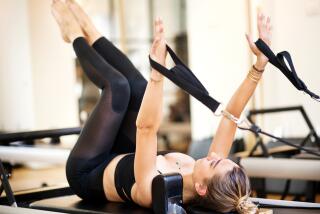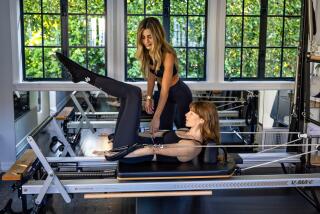Quite a stretch
- Share via
Twenty years ago, Liz Torbert noticed she was shrinking.
Diagnosed with scoliosis in her mid-20s, the Washington, D.C., woman experienced no visible effects until after menopause, when her bone density decreased. Then her spine began to collapse. Throughout her adult life she had been 5 feet, 5 1/2 inches tall; by 2000, she’d shrunk to 4 feet, 11 1/2 inches.
“My ribs were touching my pelvis,” Torbert said. “I was leaning that far over.”
Now 75 -- about six decades after most people get their growth spurts -- Torbert has regained two inches, standing 5 feet, 1 1/2 inches. She credits her new stature to three years of regular Pilates classes.
Pilates, an 80-year-old rehabilitation exercise regimen that has found a huge audience in recent years, has cultivated a reputation for being able to create longer, leaner muscles -- and increase height.
But Torbert’s case is the exception, experts say: A Pilates student who does not have a condition such as osteoporosis or scoliosis isn’t likely to gain height.
“There’s no such research to prove that Pilates will make a person taller,” said Moira Merrithew, founder of Stott Pilates, a national equipment and training company. “What it can do is improve the posture so that people stand taller.”
Chronically poor posture, Merrithew said, can be corrected by strengthening the muscles surrounding the spine. A major emphasis in Pilates is balancing the transverses abdominus, the deepest layer of the abdominals, with the multifidus, the major muscle supporting the lower back.
The normal aging process takes a toll on height. The disks that separate and cushion the vertebrae lose hydration and elasticity past the age of 25 and begin to shrink; up to an inch of height may be lost. Any height loss greater than an inch signals vertebral bone degeneration, according to the Mayo Foundation for Medical Education and Research.
Lifestyle factors can drag you down too. For those who spend too much time hunched at the computer, the trapezius and latissimus (back muscles) become stretched and weak. Shoulders and pectorals (muscles surrounding the chest) become tight. Even the neck loses mobility.
To correct these effects, Pilates exercises extend the chest. The front of the body is opened and stretched, while the muscles along the back are strengthened. The crown of the head is extended upward, lengthening the back of the neck. Over time, these moves lead to more erect posture -- and a taller look.
The “breast stroke prep,” a foundation for the full “breast stroke” move, is recommended to correct a slumping posture. The exercise is done with the belly down to the mat. With arms bent so that the hands rest just above the shoulders, the head and chest are extended off the mat. Arms may also reach upward while head and chest are lifted. (A similar movement, known as the cobra, is used in yoga.)
The move “targets the muscles of the neck, upper and middle back to extend the upper body,” said Merrithew.
The quintessential Pilates exercise is “the hundred,” aimed at strengthening the abdominals. Starting on the back, knees are pulled into the chest. The legs are then straightened so they are perpendicular to the floor. The head and upper back are lifted off the mat. Straightened arms lift several inches off the floor. Arms are parallel to the floor, hovering 2 inches above it and are pulsed up and down for five inhalations and five exhalations. Pulses are repeated 10 times to equal 100.
Yoga instructor Keith Moore doesn’t see much of a difference between the two disciplines. Moore teaches Ashtanga, a rigorous form of yoga, at the Ashtanga Yoga Center in Washington. “I’m of the opinion that Pilates and yoga are equally beneficial for the spine,” he said. “Height is regained by focusing on core strength and by gaining flexibility. The strength and flexibility must be equal partners.”
Moore said it’s very common for yoga students to report height increases. Students will come to him after medical checkups and tell him that they’ve “grown.”
“They’ll promptly come and pull me aside with a huge grin and say, ‘Keith, I just went to the doctor, you won’t believe this.’ ”
“I don’t have any science to back me up, but the anecdotal evidence is strong.”
Last year, UCLA medical professor Gail Greenberg completed a pilot study of yoga’s influence on posture. It showed that yoga could improve kyphosis, a forward curve of the spine originally believed to be an irreversible bone disorder. Researchers found that by the study’s conclusion, yoga participants had straighter spines and their height measurements had increased.
Karen Garcia, owner of Studio Body Logic in Arlington, Va., said Pilates could improve posture by building muscles to support the body against the constant tug of gravity, which otherwise compresses the spine’s spongy disks throughout the day.
Garcia swears by a move called the “roll up,” which she says is a perfect example of how Pilates simultaneously strengthens and stretches the body. It’s executed on the back with the arms extended skyward. The head is lifted and the spine is sequentially rolled, one vertebra at a time, off the mat until the arms are parallel to the floor and the fingertips can tap the toes. The movement is reversed and the spine rolls sequentially down to the starting position.
Once a Pilates student has mastered that exercise, he or she will begin to look, feel and act -- but not actually become -- taller. For Torbert, that’s good enough.






